Sedimentation in Urban Sewer Conduits, ANSYS Fluent CFD Simulation Training
$120.00 $60.00 Student Discount
- The problem numerically simulates the Sedimentation in Urban Sewer Conduits using ANSYS Fluent software.
- We design the 3-D model with the Design Modeler software.
- We mesh the model with ANSYS Meshing software.
- The mesh type is Structured, and the element number equals 14280.
- We use the dense discrete phase model (DDPM)to define water and sand particles.
Click on Add To Cart and obtain the Geometry file, Mesh file, and a Comprehensive ANSYS Fluent Training Video.
To Order Your Project or benefit from a CFD consultation, contact our experts via email (info@mr-cfd.com), online support tab, or WhatsApp at +44 7443 197273.
There are some Free Products to check our service quality.
If you want the training video in another language instead of English, ask it via info@mr-cfd.com after you buy the product.
Description
Description
The problem simulates sand particle sedimentation in a water flow channel using ANSYS Fluent software.
The sedimentation phenomenon is one of the destructive phenomena in the quality of performance of any equipment. Sedimentation can occur when the base fluid contains excess soluble particles.
The discrete sand particle’s diameters are variable, including a minimum diameter of 0.00001 m, a maximum diameter of 0.0002 m, and an average diameter of 0.000131 m. The present model is designed in three dimensions using Design Modeler software.
The model consists of a computational area in the form of a horizontal channel with a square cross-section in which the flow of water and particles move horizontally inside.
On the lower surface of the canal, three rows of plates or diagonal barriers are designed that can help the sedimentation phenomenon.
We carry out the model’s meshing using ANSYS Meshing software, and the mesh type is structured. The element number is 14280.
Sedimentation Methodology
In the present simulation, the Eulerian-Lagrangian perspective on computational fluid dynamics (CFD) is used; So that the Eulerian multiphase model is coupled with the dense discrete phase model (DDPM).
A continuous phase is defined, related to water flow, and a discrete phase is described, related to sand particles. The material of sand is defined as stagnant particles with a density equal to 2650 kg/m3.
The water flows with a flow rate of 15 kg/s and enters the channel horizontally. Simultaneously, the flow of sand particles enters the channel discretely with a flow rate of 0.21 kg/s and a velocity of 0.083 m/s.
Sedimentation Conclusion
Water flows along with sand particles into a canal, and the channel has obstacles in its path, or there is a sudden change of direction within the channel; a sedimentation phenomenon occurs; Because in areas with obstacles and with a sudden change of direction, dissolved sand particles locally relative to the main water flow becomes stagnant and slows down.
At the end of the solution process, two-dimensional contours related to water pressure and velocity and three-dimensional contours related to water pressure and velocity, and a particle sequence based on the residence time and particle diameter are obtained.
For example, the particle sequence indicates that water-soluble particles accumulate in the front area of the barrier after hitting the initial oblique barrier. Thus, the sedimentation phenomenon is possible.

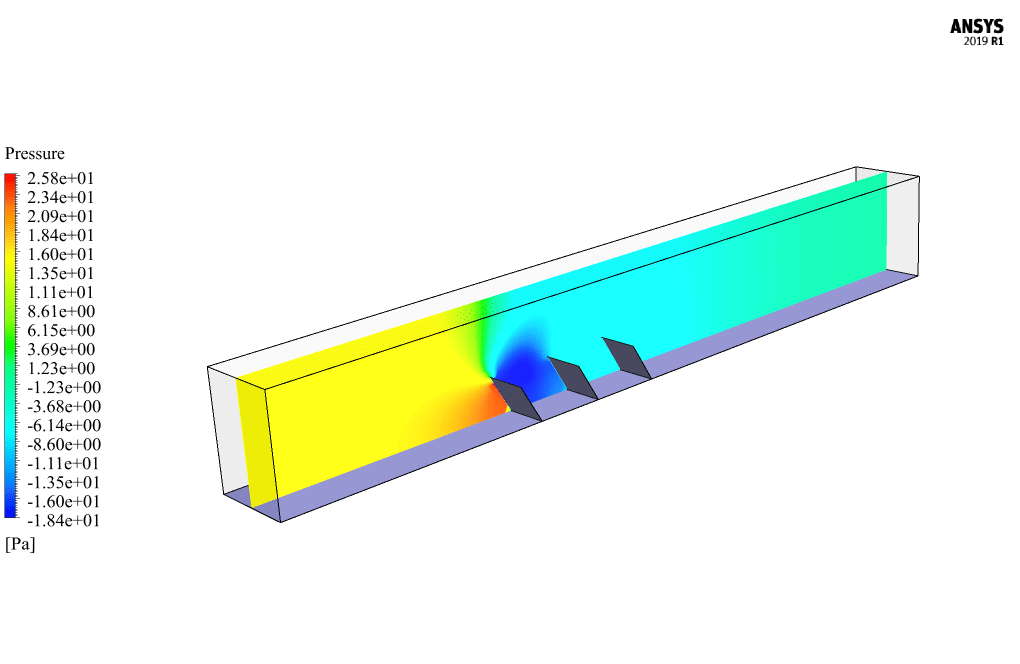
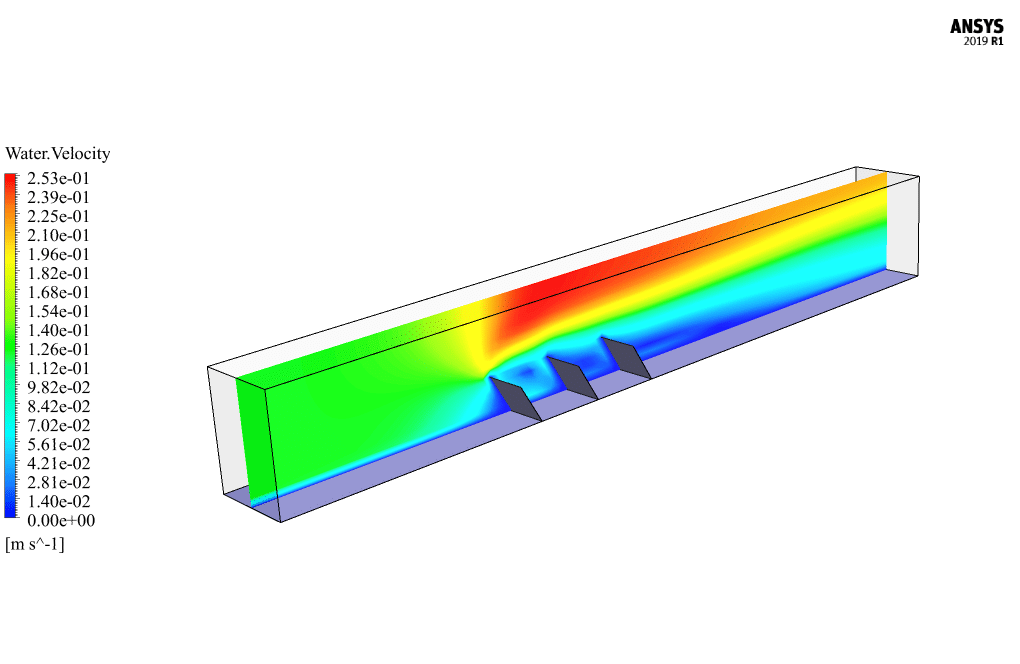
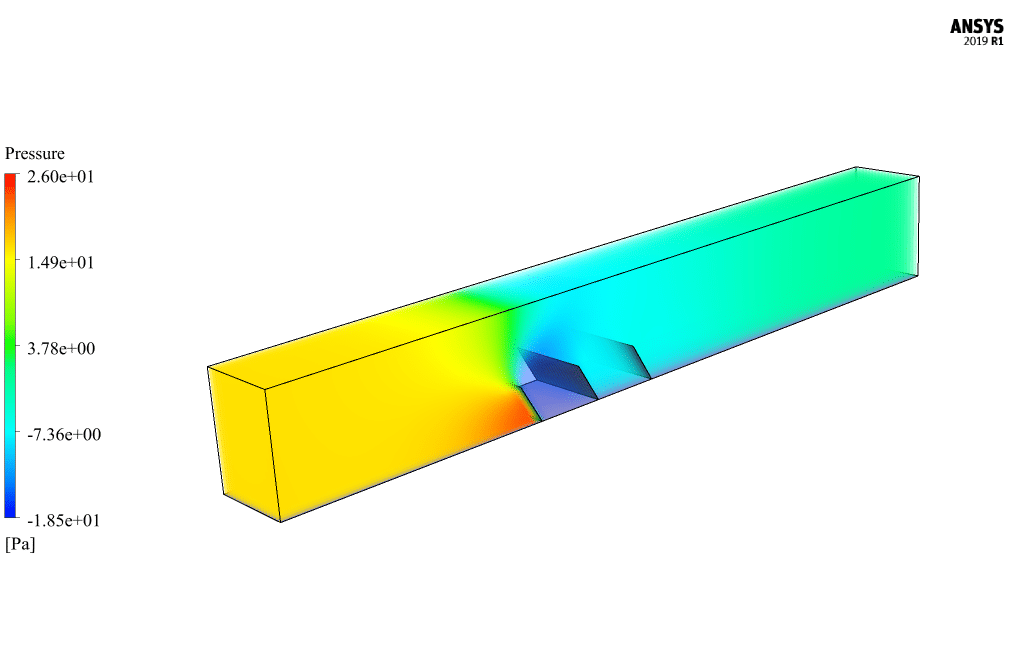
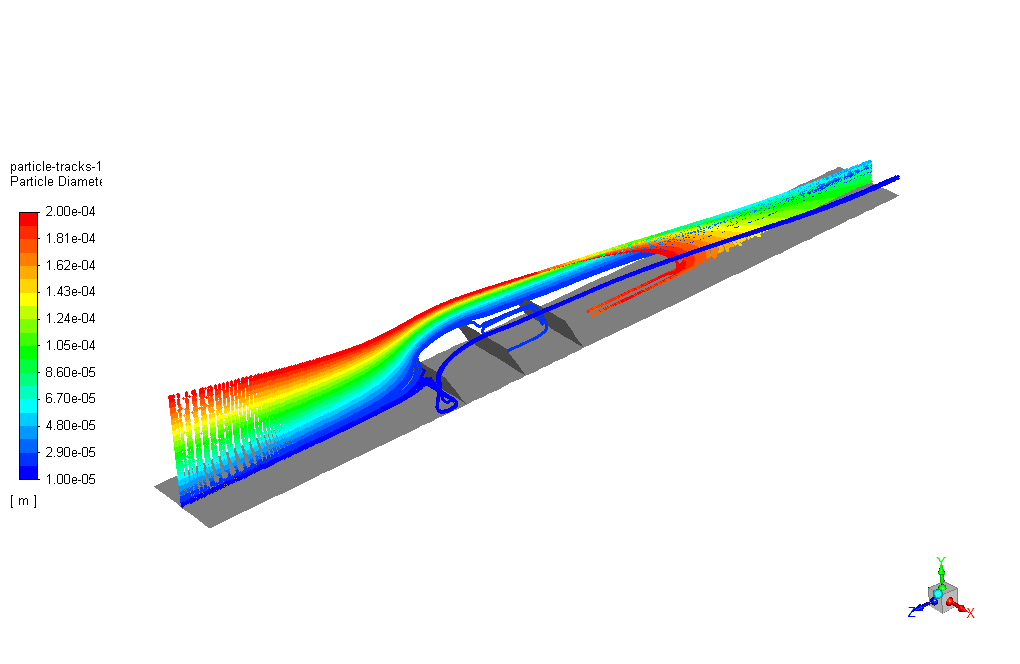
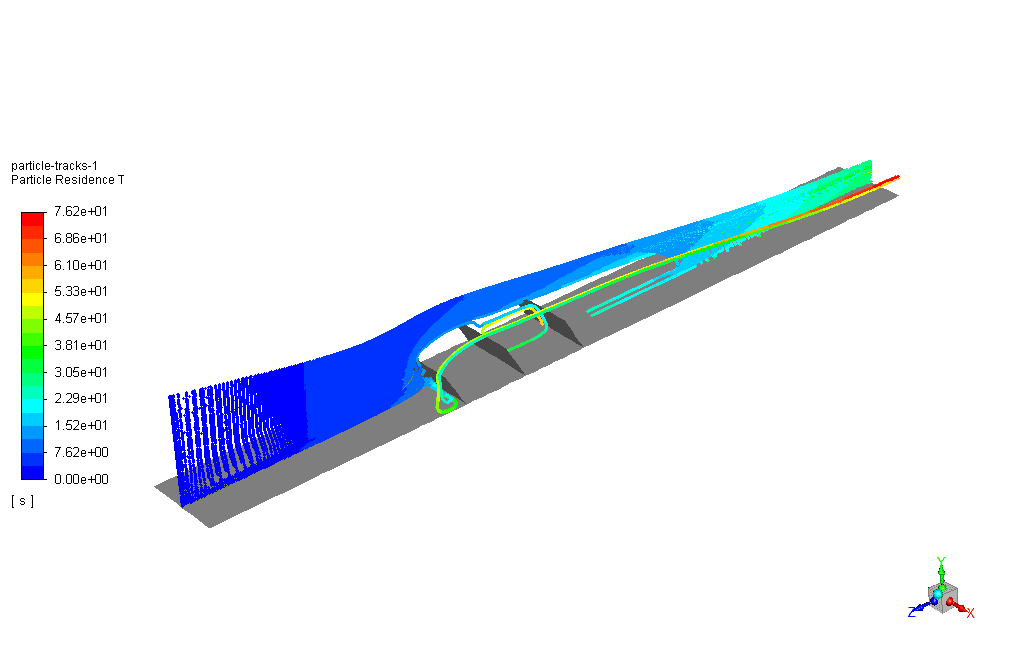
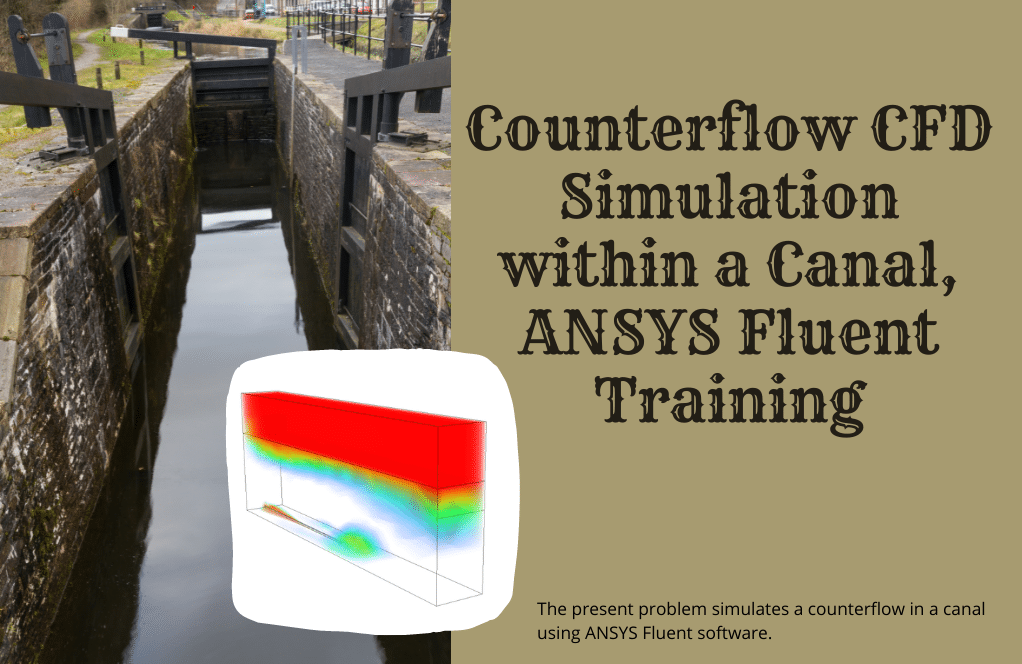
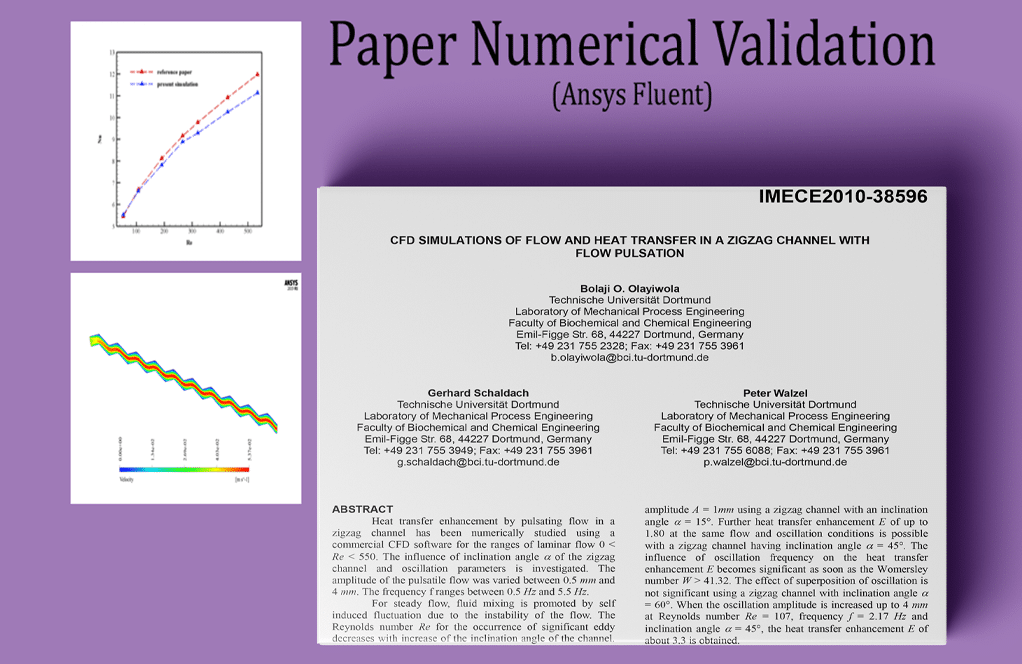

Prof. Mavis Reichel V –
Can the results of this simulation be used to optimize the design of urban sewer systems?
MR CFD Support –
Yes, the results of this simulation can provide valuable insights into the sedimentation patterns in urban sewer conduits. These insights can be used to optimize the design and operation of urban sewer systems, improving their efficiency and reliability.
Prof. Kamren Johnston DDS –
Is it possible to scale the simulation up for more complex urban sewer systems with varying diameters and flows, or would this require significant adjustments to the methodology used?
MR CFD Support –
The current methodology can serve as a foundational approach for scaling up to more complex urban sewer systems. One would need to consider the specific geometric configurations, variable diameters, and different flow rates for a more detailed model. Additional adjustments to the methodology could include refining the mesh for larger systems, implementing advanced turbulence models if required, and calibrating the sediment particle parameters based on the characteristics of the specific urban sewers being studied.
Vladimir Hill –
This course sounds useful! Does the training include lessons on how to interpret the data obtained from these simulations, like understanding the particle sequence and its significance?
MR CFD Support –
Thank you for your interest! Yes, our training goes beyond the setup and execution of the simulations. It also covers in-depth interpretation and analysis of the simulation data to ensure participants can glean meaningful insights and understand the sedimentation behavior and phenomenon fully.
Elroy Bosco IV –
The training product appears incredibly detailed; I’m wondering if it also covers strategies to minimize or manage sedimentation in real-world applications, beyond the simulation?
MR CFD Support –
We are glad you find our training detailed and informative. The focus of this simulation is primarily on the understanding and analysis of sedimentation processes within an urban sewer conduit. While strategies for minimizing or managing sedimentation may be touched upon through the understanding of the sedimentation phenomenon, this training is more aimed at providing simulation expertise rather than directly addressing solutions for real-world sedimentation issues.
Sid Reynolds –
This simulation is a testament to the power of computational fluid dynamics!
Ms. Lysanne Gislason –
Fantastic simulation for understanding urban sewer behavior. Particularly efficient is the use of different sized particle diameters to simulate real life scenarios. This kind of practical insight is invaluable for design engineers.
MR CFD Support –
Thank you for your kind words! We are delighted to hear that our simulation products are proving valuable and offering practical insights. If you ever have any questions or need further assistance, please don’t hesitate to reach out.
Joel Okuneva –
I’m very interested in learning how the sedimentation process works in urban conduits. Does the course provide visualizations that show where sediment accumulates and how it affects the water flow?
MR CFD Support –
Yes, the training provides detailed visualizations. You can observe two-dimensional contours of water pressure and velocity, as well as three-dimensional contours, which help in identifying where the sediment settles and how it interacts with the water flow. These visualizations reveal the sediment accumulations, especially after the water-soluble particles encounter the barriers placed within the channel, facilitating your understanding of the sedimentation dynamics.
Zena Roberts –
Is it possible to simulate the settling of heavier particles, like gravel, in addition to sand, using the same setup and methodology?
MR CFD Support –
While the methodology for sedimentation analysis utilizing Eulerian-Lagrangian method is consistent, the simulation of heavier particles like gravel would require an adjustment to the discrete phase properties including particle density, diameter, and perhaps the inlet velocity to reflect the behavior of gravel during sedimentation. It’s practical to use the same general setup, but parameter tuning is indeed necessary for accurate simulation results.
Kameron Hegmann PhD –
Your product gave a detailed explanation, but could you tell me if the impact of the particulate shape was considered in the sedimentation simulations?
MR CFD Support –
In the sedimentation simulation using ANSYS Fluent, the standard model primarily accounts for the size and density of the particles. While particle shape can be important, this specific simulation assumes spherical particles, as is common in CFD. This simplification is often used to reduce complexity and computation time when the goal is to understand overall trends and the impact of sedimentation.
Flossie Runolfsson –
I’m impressed by MR CFD’s thorough approach to the sedimentation phenomenon in urban sewers. I truly appreciate how the course tackled both the theory and practical aspects. The visuals provided for pressure and velocity in different contours was particularly helpful. Excellent work on curriculum design – your resources have significantly deepened my understanding of CFD in urban sewer systems.
MR CFD Support –
Thank you so much for your kind words! We’re thrilled to hear that you found the sedimentation simulation course informative and the visuals effective. Your appreciation fuels our passion for creating thorough and practical CFD courses. We hope that our training continues to be beneficial for your learning journey.
Brant Davis MD –
Fantastic training content! The use of both Eulerian and Lagrangian perspectives provided thorough insight into the sedimentation process. The structured approach to incorporating variable sand particle diameters and the detailed simulation setup enhanced my understanding of particle behavior in fluid flow, especially how channel alterations like obstacles can influence sedimentation. Thank you, MR CFD, for such an informative simulation that’s equally beneficial for academic learning and professional development in fluid dynamics.
MR CFD Support –
We’re truly grateful for your kind words and glad to hear you found the training content to be thorough and informative. It’s wonderful to know that the simulation has enriched both your academic learning and professional expertise in fluid dynamics. Thank you for choosing MR CFD, and we look forward to providing you with more valuable learning materials in the future!
Steve Zemlak –
This analysis appears to be very complex. The way the sand particles settle must be intriguing to observe. Could you provide more details on how the DDPM-DPM coupling is managed in the simulation?
MR CFD Support –
In the simulation, the DDPM-DPM coupling integration allows for calculating interactions between the continuous water phase and the discrete sand particles. The Eulerian approach represents the water as a continuous phase, while the Lagrangian track of the DDPM calculates the trajectory of each discrete sand particle as it moves through the water. The system considers forces like drag, gravity, and also the interaction with the channel walls, including the barriers which help to induce sedimentation. These multifactor interactions determine when and where the particles settle within the channel.
Alexzander Gislason –
Wow! The details in the Sedimentation CFD Simulation are incredible. The use of Eulerian-Lagrangian perspectives for capturing the sedimentation process sounds fascinating.
MR CFD Support –
Thank you so much for your kind words! We are thrilled to hear that you appreciate the intricacy and depth of our Sedimentation in Urban Sewer Conduits CFD Simulation. We always strive to provide detailed and accurate simulations to help our users understand complex phenomena such as sedimentation. If you have any further feedback or need more information on our products, feel free to reach out!
Alexys Kirlin –
What do the particle sequence contours indicate in the context of sedimentation?
MR CFD Support –
The particle sequence contours visually demonstrate the distribution and accumulation of particles as they interact with obstacles and structural changes within the channel. These contours show regions where sedimentation is likely to occur, highlighting areas where sand particles slow down or become stagnant after hitting barriers, promoting the sedimentation phenomenon.
Prince Weissnat –
The level of detail in this simulation is truly impressive.
Emerald Boyer –
I loved the practical aspect of the sand sedimentation simulation—seeing how particles gather near the barrier was eye-opening. Well done!
MR CFD Support –
Thank you for your positive feedback! We’re glad to hear that the sedimentation simulation provided valuable insights and that you enjoyed the practical demonstration of the phenomenon. It’s our aim to offer simulations that are both informative and engaging, and we appreciate your acknowledgment of our efforts.
Kailey Kris –
What impact do the diagonal barriers have on the sedimentation of sand particles in the simulation?
MR CFD Support –
The diagonal barriers in the channel create regions where the flow is disrupted and slowed down. This allows for the sand particles, which may have been suspended in the flow, to settle due to gravity, thereby aiding in the process of sedimentation. They essentially act as traps that increase the efficiency of sediment removal from the water flow.
Mr. Ali Kutch –
I’m impressed by the particle tracking and sedimentation analysis capabilities in urban sewer conduits using ANSYS Fluent. It seems like a valuable tool for predicting and preventing potential sediment build-up issues.
MR CFD Support –
Thank you for your positive feedback! We’re glad to hear that you find the particle tracking and sedimentation features in ANSYS Fluent valuable for urban sewer analysis. It’s a priority for us to provide tools that can help in effective prediction and prevention of sediment-related issues. If you need further assistance or have any more questions about our products, please feel free to reach out.
Wilford Christiansen –
I’m delighted with how clear the sedimentation effects were shown in the simulation! It really helped understand the impact of channel designs on sedimentation. Do you also provide tutorials on how to design the channel and barriers for optimized sedimentation rates?
MR CFD Support –
Thank you for your positive feedback! It’s wonderful to hear that the sedimentation effects were clear and educational. We do offer additional tutorials and instructional materials on various aspects of CFD, including optimized channel and barrier design for sedimentation processes. Remember to explore our range of learning products to find the most suitable tutorial for your needs.
Martine Marks –
This training provided everything I needed to understand sedimentation! Just one question: how do the different diameters of sand particles affect the sedimentation rate?
MR CFD Support –
The different diameters of sand particles significantly impact sedimentation rates. Larger particles tend to settle more rapidly due to their greater mass, which causes a higher settling velocity. Conversely, smaller particles have slower settling velocities and may be carried further by the flow before they settle. The simulation includes varying particle sizes to accurately represent and predict this behavior in an urban sewer conduit context.
Mrs. Blanche Thompson –
The product provided a comprehensive understanding of phenomena such as sedimentation in urban sewer systems. Through the use of ANSYS Fluent software, critical analyses surrounding the movement, accumulation, and flow of water and sand particles in the channel were told in an engaging and informative manner. The structured mesh and the use of the Eulerian-Lagrangian approach demonstrated a high level of detail, allowing for a thorough understanding of the sedimentation process. Well done on integrating a practical example of real-world complexity into CFD training. I look forward to applying the concepts learned in similar future analyses.
MR CFD Support –
Thank you for your positive feedback. We are thrilled to hear that our Sedimentation in Urban Sewer Conduits simulation training was helpful and provided you with valuable insights into the sedimentation process. We strive to deliver high-quality content that encompasses real-world scenarios to aid our users in better understanding complex phenomena. Your comprehension confirms that we are achieving these goals. We’re looking forward to supporting you in your future CFD endeavors!
Vicente Macejkovic II –
Does the structure of the obstacles inside the channel have a significant impact on sedimentation patterns?
MR CFD Support –
Yes, the structure of the obstacles inside the channel affects sedimentation patterns. These obstacles induce dead zones and flow separation, creating areas where the velocity decreases, and sedimentation is more likely to occur. The modeling thus considers these components crucial in understanding and predicting sedimentation phenomena.
Miller Skiles –
I’m fascinated by the sediment simulation! Could you further explain the significance of the three rows of plates in the sedimentation process?
MR CFD Support –
Certainly! The three rows of plates, or diagonal barriers, in the channel are strategically designed to induce zones of lower flow velocity. This allows for the creation of favorable conditions for sand particles to settle out of suspension, thus aiding the sedimentation process. When the water and sand particle mixture encounters these barriers, the flow is disrupted, which can lead to the stagnation of water flow and reduced particle velocity. Consequently, this environment facilitates the settling of particles due to gravity, enhancing the efficiency of the sedimentation process within the conduit.
Ellie Bergnaum –
I’ve thoroughly enjoyed learning about the sedimentation process through this CFD course. The complex interactions between fluid flow and particle sedimentation were clarified excellently.
MR CFD Support –
Thank you for your kind words! We are thrilled to hear that our CFD simulation training provided you with a clear understanding of sedimentation in water channels. Your satisfaction is our top priority, and it’s great to see our product making a difference. If you have any further insights to share or need assistance, we’re here for you.
Jefferey Langworth –
The structured mesh used in the simulation, was it able to accurately capture the areas around the sediments and plate or diagonal barriers?
MR CFD Support –
The use of structured mesh in the simulation ensured high accuracy around the plates or diagonal barriers, and sediment areas, providing the needed resolution to capture the sedimentation phenomenon effectively.
Prof. Jeffrey Koss III –
I appreciate how the sedimentation phenomena were presented in the results—very useful for understanding water treatment processes. Thank you for the detailed training simulation.
MR CFD Support –
Thank you for your positive feedback! We’re glad to hear that our simulation on sedimentation in urban sewer conduits has provided you with valuable insights. If there’s anything else we can help with, feel free to reach out!
Cicero White DVM –
Could you please explain whether this training product includes guidance on how to interpret particle sequence contours and their relationship to sedimentation?
MR CFD Support –
Absolutely! The training product includes detailed guidance on analyzing simulation results, which encompasses the interpretation of particle sequence contours. The tutorial explicitly demonstrates how such contours reveal the sedimentation patterns within the channel. By understanding the residence time and diameter of particles and their spatial distribution, you are adeptly guided on how to relate this information to the sedimentation process at various locations within the model.